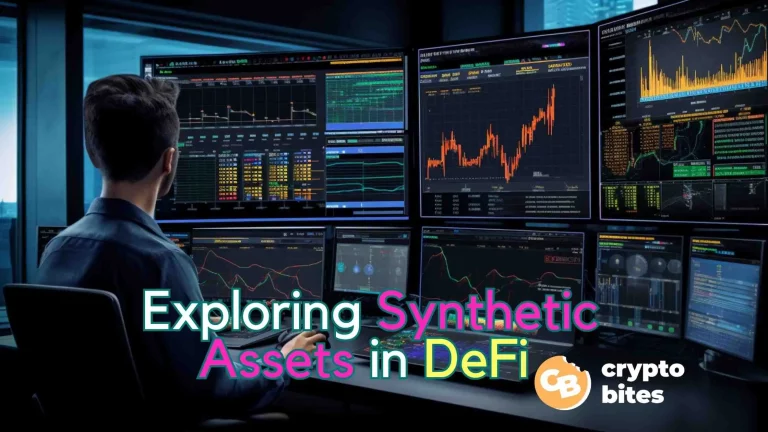
Synthetic Assets in DeFi: Exploring Mirror Protocol and Synthetix
Decentralized finance, popularly known as DeFi, is reimagining the traditional financial system. In just 2022, DeFi users skyrocketed to an estimated 4.87 million, with an anticipated further surge in 2023. DeFi offers a world of opportunity, especially for those underserved by conventional finance, while also showcasing flexibility within the blockchain, unearthing previously untapped potentials.
One major development spurred by the blossoming DeFi landscape is the emergence of synthetic assets. This unique class of assets has rapidly gained attention, serving a diverse group of users. Let’s delve into the fascinating world of synthetic assets and the benefits they offer.
Decoding Synthetic Assets and Their Use Cases
What are Synthetic Assets?
Synthetic assets are financial instruments meticulously engineered to mirror the price movement of a specific asset. These are created by repackaging and amalgamating various financial products to mimic the target asset’s value and cash flows.
They find use in several scenarios, such as hedging against market risks, accessing markets that might be difficult to trade, or acting as a core component in yield farming strategies. In addition, offering liquidity to decentralized exchanges enables innovative yield generation.
Synthetic Asset Use Cases
There’s a broad spectrum of synthetic assets, including bonds, currencies, and stocks. Tokenized derivatives are another prevalent type of synthetic asset. However, tokenized derivatives function differently than traditional derivatives that depend on an underlying asset like a currency, stock, or commodity for value appreciation.
Tokenized derivatives are independent of the asset and can be transferred and sold online without direct investor control. An outstanding feature of tokenized derivatives is price tracking. This establishes a correlation between an asset and the derivative, such that price changes in the asset influence the derivative.
For instance, when a tokenized Litecoin future is created, its value could be tied to its price, so any fluctuation in Litecoin’s value directly impacts the futures contract’s price. This implies that investing in a Litecoin futures contract doesn’t necessitate owning a Litecoin or involving intermediaries.
For investors lacking direct access to traditional financial markets, tokenized derivatives present a unique opportunity for liquidity and accessibility.
Mirror Protocol: A Gateway to Synthetic Stocks in DeFi
Mirror Protocol is a leading DeFi platform facilitating trade in synthetic assets. It empowers users to invest in real-world commodities and stocks without buying the underlying assets. Boasting features like creating digital synthetic stocks mirroring real-world stocks, this platform is decentralized, cost-effective, and integrates smoothly with oracles for precise asset pricing.
With Mirror Protocol, you can experience yield farming and staking, allowing you to earn rewards for providing liquidity. It also accepts stablecoins as collateral in smart contracts, creating synthetic assets tracking real-world assets and their price fluctuations.
Upon minting, the synthetic assets are sent to your wallet, allowing you to trade freely on decentralized exchanges. The platform also offers a liquidation mechanism for maintaining the value stability of synthetic assets.
Synthetix: A Platform for Synthetic Assets in a Decentralized Ecosystem
Just as Mirror Protocol has established its niche, another DeFi platform, Synthetix, paves the way for creating synthetic assets and enabling a decentralized exchange for unique derivatives.
Introduction to Synthetix
Launched in 2018, Synthetix focuses on creating synthetic assets, a powerful driving force in the evolving DeFi space. It uses its native token, SNX, as collateral to deliver synthetic assets, streamlining the process of accessing various financial instruments.
Notably, Synthetix has an exchange where users can buy, sell, and trade these synthetic assets against a stablecoin.
One of its standout features is a robust system of incentives and rewards. Users often receive token rewards, encouraging an active and vibrant trading ecosystem. Moreover, Synthetix employs a liquidation mechanism for stabilizing the value of synthetic assets and uses a network of oracles to determine the real-time value of the underlying real-world assets.
The Mechanics of Trading on Synthetix
Synthetix operates with a straightforward mechanism, akin to many similar platforms creating synthetic assets. The journey starts when you deposit tokens and mint synthetic assets. The minting process is executed by smart contracts that deliver the new assets directly to your wallet.
The price feeds from reliable oracles enable Synthetix to track and determine the underlying assets’ real-world value accurately. Once you hold the synthetic assets in your wallet, you can trade them on the Synthetix exchange.
Advantages and Potential Drawbacks of Using Synthetix
Advantages:
- Elevated Exposure: Synthetix broadens your reach to diverse real-world assets.
- Trustless and Transparent Platform: As a decentralized platform, Synthetix isn’t under the control of a single entity, promoting trust and transparency.
- High Liquidity: Thanks to its large and active community, you can buy and sell assets seamlessly.
- Attractive Incentives: The platform offers enticing rewards and incentives for active participation.
Potential Drawbacks:
- Liquidity Risk: A potential downside in liquidity risk comes with the liquidation mechanism. If the value of the collateral drops, any synthetic asset can be liquidated, resulting in losses.
- Reliability on Oracles: The dependence on oracles for accurate price feeds may also pose a risk. Inaccuracies or failure of oracles can potentially lead to losses.
- Uncertain Future: The DeFi ecosystem is still emerging, bringing uncertainty that may limit Synthetix’s future performance.
- Acceptance among Traditional Investors: Synthetix is a relatively new community that might take time to gain acceptance among traditional investors.
Navigating Challenges & Regulatory Implications of Synthetic Securities in DeFi
Synthetic securities hold an enticing future. However, integrating these into the DeFi ecosystem isn’t a walk in the park. Here’s an exploration of synthetic assets’ legal, regulatory, and risk considerations.
Legal and Regulatory Landscape for Synthetic Assets
In certain jurisdictions, synthetic assets may be classified as securities. As a result, they fall under specific regulations, including:
Investor protection and registration requirements when treated as securities.
In cases where synthetic assets track commodities, they are deemed equivalent to commodities. Consequently, these are subject to reporting requirements and position limits.
Platforms creating and providing synthetic assets must comply with anti-money laundering laws. This safeguard aims to curb potential terrorist financing and other illegal activities.
A few platforms may be liable for taxes on their assets, which can inflate their price.
DeFi platforms may need to procure a license or abide by local jurisdictions to facilitate cross-border trading within the current regulatory framework.
Minimizing Risks and Ensuring Compliance
The creation and management of synthetic assets come with their share of risks. However, the following proactive measures can mitigate these risks and enhance compliance:
- Conduct comprehensive due diligence before investing in a platform to minimize risk.
- Evaluate the reliability of oracles to protect against inaccurate information.
- Diversification is key. You can reduce the likelihood of significant losses by spreading investments across multiple decentralized networks.
- Platforms can integrate robust risk management features to handle potential heavy losses.
- Transparent operations and clear communication of their protocols can foster trust among users.
- Keeping abreast of the changing regulatory environment can help safeguard against potential legal risks. It’s also essential for platforms to quickly adapt to regulatory changes and adjust their practices accordingly.
- The DeFi regulatory landscape is complex. Engaging with regulators to understand new advancements and apply them beneficially is crucial. Being open to sharing your opinion can play a significant role in driving positive changes.
Final Thoughts
Synthetic assets serve as a powerful alternative to traditional financial derivatives. They offer low cost, exceptional accessibility, and remarkable flexibility.
Today, these assets primarily replicate stocks and commodities, but the future may see an expansion into other asset classes, such as art or real estate.
The main concern with these assets revolves around liquidity risk. However, platforms are already gearing up to develop innovative liquidity solutions to address this issue. Platforms and regulatory bodies are working together to establish transparent regulations to foster a robust and reliable DeFi ecosystem.




